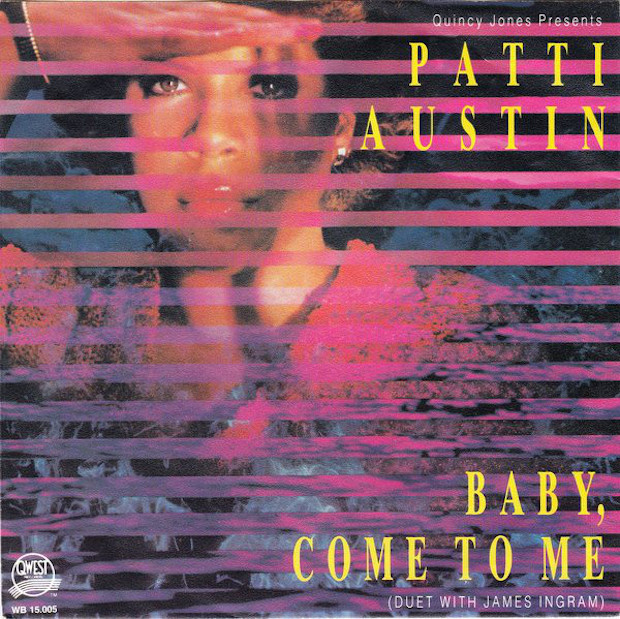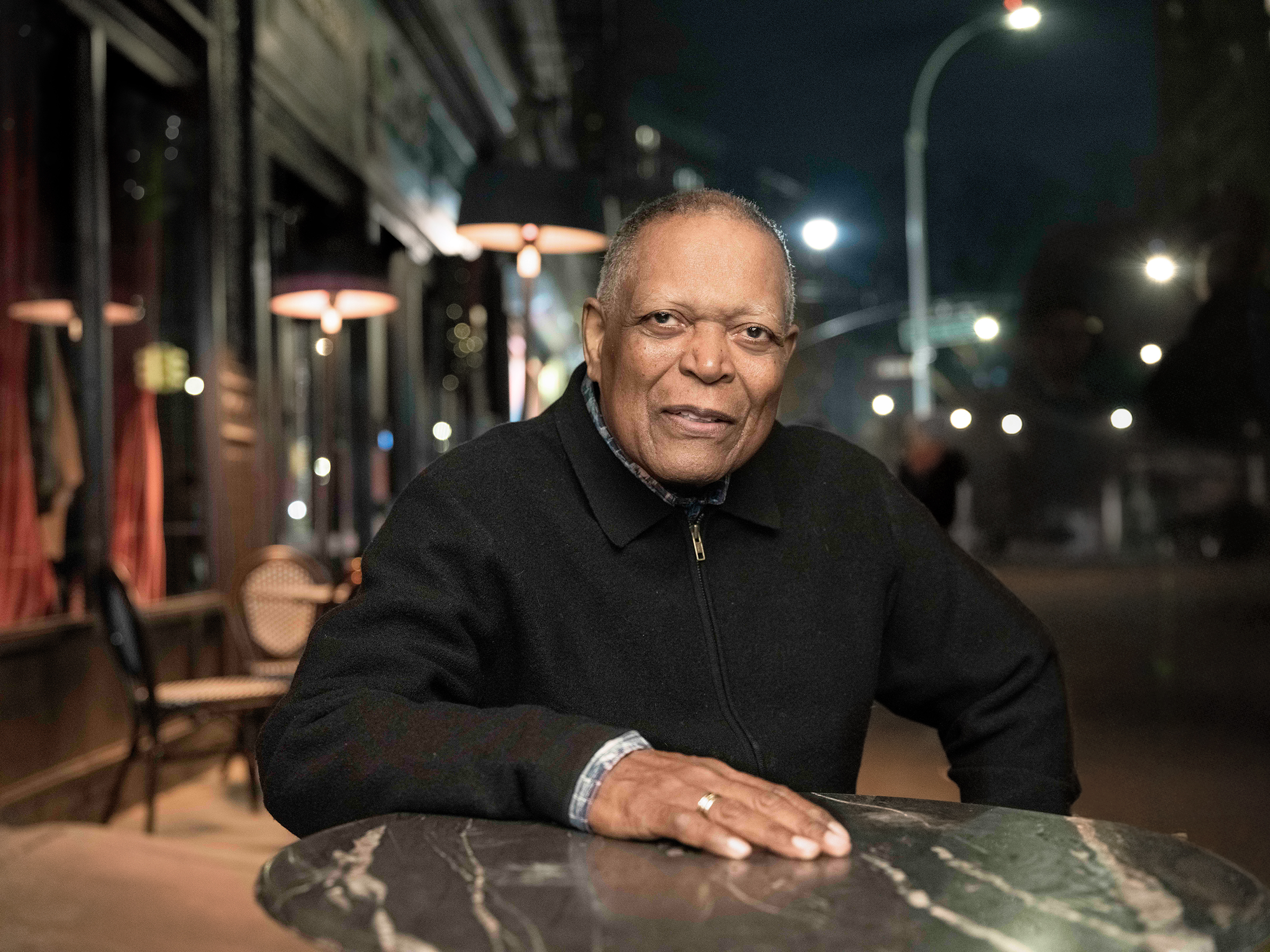In The Number Ones, I'm reviewing every single #1 single in the history of the Billboard Hot 100, starting with the chart's beginning, in 1958, and working my way up into the present.
Patti Austin & James Ingram - "Baby, Come To Me"
HIT #1: February 19, 1983
STAYED AT #1: 2 weeks
We don't see a lot of opening acts in this column. If you have the #1 song in America -- even if it's just for a week, even if you never approach that peak again -- you're not an opening act. You're a headliner. For the two weeks in 1983 that "Baby, Come To Me" was #1, Patti Austin and James Ingram were headliners. But they were opening acts, too. "Baby, Come To Me" was an early rumble, a warning of the pop-chart earthquake that was about to hit.
Almost everyone involved in "Baby, Come To Me" had something to do with Michael Jackson. Quincy Jones produced the song. Songwriter Rod Temperton, former keyboardist for the British disco-funk group Heatwave, had written "Rock With You," the Michael Jackson song that hit #1 in 1980. (Heatwave's highest-charting single, 1977's "Boogie Nights," peaked at #2. It's an 8. Temperton also wrote Jackson's 1984 single "Thriller," which peaked at #4. That one is a 9.) Many of the session musicians who played on "Baby, Come To Me" -- Greg Phillinganes, Michael Boddicker, David Foster, Paulinho da Costa, Toto's Steve Lukather -- also played on Michael Jackson's album Thriller. Jackson himself didn't directly have anything to do with "Baby, Come To Me," but there's still something cosmically appropriate about "Baby, Come To Me" hitting #1 just before the Thriller wave finally crashed over the pop charts.
Patti Austin and James Ingram had their own Michael Jackson connections, too. Patti Austin duetted with Jackson on "It's The Falling In Love," a deep cut from Off The Wall. James Ingram, along with Quincy Jones, co-wrote Jackson's Thriller single "PYT (Pretty Young Thing)," which peaked at #10. (It's a 9.) Both Austin and Ingram came by their Jackson connections because of Quincy Jones.
Jones always claimed that he was Patti Austin's godfather, though I don't know whether he ever had the official title. Austin, the daughter of the jazz trombonist Gordon Austin, was born in Harlem and raised on Long Island. She was a vocal prodigy. At age five, she sang at the Apollo Theater after Dinah Washington brought her onstage. As a child, she toured with previous Number Ones artist Sammy Davis, Jr. and sang on a handful of TV variety shows.
Austin released a good number of singles in the '60s and '70s, and some of them made the R&B charts, but none of them crossed over to the Hot 100. Most of the time, Austin made her living singing commercial jingles or doing backup session work. She'd been one of the backing singers, for instance, on "50 Ways To Leave Your Lover," the Paul Simon song that hit #1 in 1976.
James Ingram was about the same age as Patti Austin, but he'd had even less success before the two of them hit #1 together. Ingram came from Akron. After going to the University Of Akron on a track scholarship, he moved to Los Angeles and worked as a keyboardist for artists like Ray Charles. For a little while, he was in the Revelation Band, the group that plays in the low-budget 1975 blaxploitation classic Dolemite. (I love that movie.) Ingram didn't really think of himself as a singer, but he did have a side hustle singing on demos. That's how Quincy Jones heard him.
Both Austin and Ingram sang on Jones' 1981 album The Dude, and both of them signed to Jones' Qwest label. ("One Hundred Ways," an Ingram-sung track from The Dude, peaked at #14; it remains Quincy Jones' highest-charting single as a lead artist.) Austin and Ingram made sense together. Both of them came out of quiet storm, the lush and tender R&B subgenre that was the default sound of Black radio in the early '80s. Quiet storm was aspirational music, slick and warm and heavily orchestrated. Many of its biggest stars, like Anita Baker and Luther Vandross, only rarely crossed over to the pop charts, especially in the genre's early-'80s heyday. Especially in the days when MTV wasn't playing Black artists or ballads, singers like Patti Austin and James Ingram would do well on the R&B charts, but they'd barely cause a ripple on the Hot 100.
Initially, that's what happened with "Baby, Come To Me." Austin released her Quincy Jones-produced album Every Home Should Have One in the fall of 1981. "Baby, Come To Me" was the album's third single. The first two were both sophisticated mid-tempo dance-pop songs, and neither did much damage on the Hot 100. "Do You Love Me?" missed the Hot 100 entirely, and "Every Home Should Have One" peaked at #55. When it was first released as a single in April 1982, "Baby, Come To Me" peaked at #73 before dropping off of the Hot 100. But then General Hospital happened.
I'll confess that I don't quite understand how General Hospital managed to have such an impact on the charts in the '70s and early '80s. Were that many people really watching this soap opera every single day? Didn't people have to work? VCRs were still luxury goods back then, so I don't think too many people were taping the shows and then coming home to watch them. And yet a song could blow the fuck up just by being associated with General Hospital. Herb Alpert's "Rise" got to #1 in 1979 after showing up in multiple General Hospital episodes. "Jessie's Girl" hit #1 in 1981 after Rick Springfield joined the show's cast. General Hospital was a cultural force. Maybe you had to be there.
"Baby, Come To Me" blew up after General Hospital used it in a love scene between Luke Temple and some lady named Holly. (Laura, Luke's wife, was off the show at that point.) NBC started getting phone calls and letters about "Baby, Come To Me," so Qwest re-released the single, and that's what it took to push it to #1.
https://youtube.com/watch?v=lLuisRiIGJI
"Baby, Come To Me" is a perfectly fine song that would've never stood a chance if it hadn't become a part of the General Hospital phenomenon. It's definitely a smooth piece of work. Jones' production on "Baby, Come To Me" doesn't have the same immediacy or energy as what he brought to Thriller, but it's got layers. Jones piles up they keyboards, getting them to do pillowy and symphonic things. "Baby, Come To Me" is a ballad, but it's a ballad with a beat. If you focus on individual elements -- the assured murmur of Eddie Watkins, Jr.'s bass, say, or Steve Lukather's whispery guitar clicks -- you'll find a lot to admire. But "Baby, Come To Me" also melts into the background -- which, to be fair, is more or less what it was designed to do.
Austin and Ingram are both total professionals on "Baby, Come To Me." Both of them get chances to really blow, to flex their power and technique. But they do it subtly, without overwhelming the track. (Michael McDonald, who sings backup, manages not to yarl his way to the front of the mix, which is some kind of achievement for him. McDonald, already a Number Ones artist as a Doobie Brother, will eventually appear in this column as a solo artist.) Austin is bluesy and conversational, and her voice seems to melt into the chorus. Ingram gets a little showier, hitting a few grandly growly notes, but he always keeps it smooth.
Lyrically, "Baby, Come To Me" doesn't really say a whole lot. Austin and Ingram both play characters who feel like they're meant to be together. On the first verse, Austin hints at the idea that they might've broken up at some point, that she's come to realize what she was missing: "Thinking back in time when love was only in my mind, I realize ain't no second chance/ You've got to hold on to romance, don't let it slide." But the song never acknowledges any further complications. There's no tension. They don't want to be alone. They want to be together. That's it.
Austin and Ingram were both in their early thirties when the hit #1, and "Baby, Come To Me" is grown-folks music. Soon, the charts would have even less room for grown-folks music. If you look at the songs that hit #1 in 1983 and 1984, a true blockbuster era for pop music, then "Baby, Come To Me" is an outlier. Almost everything else that topped the charts is bigger, faster, more sensationalistic. "Baby, Come To Me" is more of a warm bath, a long exhale.
Patti Austin hasn't been in the top 10 since "Baby, Come To Me." Her follow-up single was another James Ingram duet, 1983's "How Do You Keep The Music Playing?,"and it peaked at #45. She's only been on the Hot 100 a few times since then. She's kept working, and she appeared in 20 Feet From Stardom, the 2013 documentary about backup singers. In 2001, Austin was booked to perform at a Michael Jackson tribute show in New York, and she was going to fly out on United flight 93, one of the planes that crashed on 9/11. But her mother suffered a stroke, and she changed her schedule, missing that flight. She's still with us. James Ingram, on the other had, died of brain cancer last year at the age of 66. But we'll see Ingram in this column again.
In the second week that "Baby, Come To Me" sat at #1, Thriller finally ascended to #1 on the album charts, breaking the hold that Men At Work's Business As Usual had over the top spot. After Thriller finally hit its apex, things were different. We're getting to that.
GRADE: 6/10
BONUS BEATS: Here's Houston underground rap legend Lil Keke interpolating "Baby, Come To Me" on the 2001 track "Come And Smoke With Me":
(Lil Keke has never appeared on the Hot 100 as a lead artist, but he rapped on Paul Wall's 2006 single "Break 'Em Off," which peaked at #72.)






